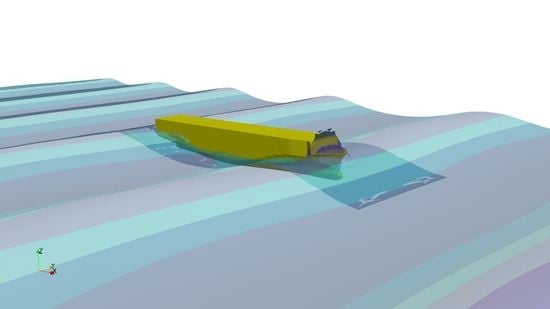In ocean engineering, predicting seakeeping responses in high-amplitude waves is of high value for various design aspects. Avoiding unwanted motions and accelerations can result in significant savings in fuel, equipment damage, general comfort, etc. From a structural safety viewpoint, navigating in an extreme sea state can cause large vertical bending moments amidships for slender, long, ocean-going vessels. As for seakeeping performance, relevant wave-induced motions and scattering effects, for instance, lead to added resistance contributions. The adequate prediction of added resistance in waves enables for interventions in terms of reducing fuel consumption in the early stage of ship design. Today, the most common methods for the numerical estimation of ship motions and added resistance involve potential-flow three-dimensional (3D) or strip-theory codes within a perturbation approach. However, these methods cannot properly capture all nonlinear effects relevant in rather steep waves [
1]. The use of Reynolds-averaged Navier–Stokes (RANS) equations coupled with rigid body motion solvers can overcome the limits of the methods above, as it allows nonlinear effects associated with both potential- and real-flow effects to be accounted for. Numerical investigations of the seakeeping characteristics of floating objects in large waves with fully viscous CFD within a finite volume framework are still limited [
2,
3,
4,
5]; this is reasonably due to the high computational cost on one side and reliability issues on the other. A distinguishing challenge when dealing with high-amplitude body motions within CFD is the generation and application of an appropriate dynamic mesh strategy. This is especially crucial when targeting second- and higher order wave-induced loads, as they are smaller than linear loads and therefore more sensitive to numerical discretization strategies; one must note that they also represent a challenge for experimental studies—in fact, those in this context are somewhat limited. Gao et al. [
6] compared and validated several dynamic mesh strategies, including the scenario of ship capsizing in regular beam-sea waves. For large amplitudes of motion, overset (chimera) grids seem to be the most appropriate. The concept behind the overset is to combine any number of independent computational domains with the motion pre-specified or computed for each individual domain. In computational marine hydrodynamics, this concept is a useful tool for evaluating, e.g., rudder–hull–propeller interaction, zig-zag maneuvers, or any other complex hydrodynamic scenarios involving large body motions. For instance, Galbraith and Boulogouris [
7] simulated roll motions of a tumblehome hull undergoing a parametric resonance, which can result in very high roll angles depending on the hull geometry, level of damping, ship heave and pitch motions, and incident-wave features. The overset mesh technique has proved its robustness in numerous seakeeping numerical investigations [
8] in which large amplitude motions are not restricted, as in more conventional morphing meshes. The price to pay for such a technique is the increased computational cost. Apart from the dynamic mesh strategy, simulating free-surface waves is by no means trivial in computational fluid dynamics. Challenges encountered in creating a numerical wave tank include a loss of wave height in the case of an insufficiently fine mesh (dissipative errors), inaccuracies in the wave-propagation mechanisms (dispersive errors), unwanted wave reflections at the outlet boundary, etc. Jacobsen et al. [
9] provide substantial documentation in this field in the context of a publicly available toolbox for free surface wave generation and absorption in OpenFOAM
® [
10]. Furthermore, appropriate turbulence modeling needs to be addressed for wave generation if turbulence is expected to matter for the examined wave–body interaction problems. The most used turbulence models in marine applications are k-ε and k-ω SST [
11]. However, with both models, numerical instability occurs with free-surface waves through the non-physical build-up of turbulent viscosity, thus creating high and unrealistic damping of the waves [
12]. The overall influence of turbulence modeling in seakeeping simulations within CFD is speculative, since the pressure and velocity gradients in the flow are very high near the hull, making single-phase turbulence models rogue [
13]. Moctar et al. [
14] even suggest omitting fine boundary layers along the hull if viscous effects are to be neglected. However, further investigations are needed in this area. In the present paper, a seakeeping response assessment, with added resistance included, is performed for two ships for which model-test results are available. The first case concerns a 6750 TEU containership model with zero speed in head-sea regular waves, in which pitch and heave responses are analyzed. Preliminarily, a thorough investigation was performed regarding the mesh quality within CFD for the propagation of waves with a two-dimensional (2D) numerical wave tank; an assessment was performed for five different wave heights and keeping the wavelength fixed and equal to the ship length. The second case refers to the KRISO containership model advancing in head-sea waves. Both cases are investigated with two numerical tools for marine hydrodynamics: (A) the commercial code Wasim from DNV classification society, based on potential flow theory, i.e., a Rankine panel method, and including second-order nonlinear effects within a perturbation approach, hereafter briefly indicated as PF; and (B) the open source CFD toolkit OpenFOAM
® based on the co-located finite volume method (FVM), hereafter briefly indicated as CFD. This comprehensive study provides additional insights into the performance of these two hydrodynamic tools for estimating ship response and added resistance in waves, their shortcomings, and their advantages. The rest of this paper is structured as follows. In
Section 2, the experimental setups and test matrices for the two studied cases are outlined. The two selected numerical tools are described in
Section 3. In the same section, the incident-wave parameters for the first experimental case are used to carry out a systematic analysis to identify the grid size and time-step needed to limit the numerical errors of the CFD solver. The results from all seakeeping simulations are documented in
Section 4, together with their comparison against the corresponding physical data, and the main conclusions are drawn in
Section 5.










































